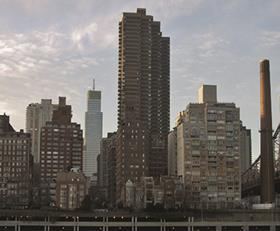A friend is selling her apartment on East 58th Street because she fears losing her views to a skyscraper condo tower across the street.

Her building, the 47-storey Sovereign, is to be eclipsed by an 80-storey project designed by Foster & Partners and developed by Joseph Beninati’s Bauhouse Group.
But Beninati might have more to worry about than my friend does. Just as in London, Manhattan’s stratos-tier property market faces a fall to Earth. Beninati’s project, named 3 Sutton Place, has yet to secure construction permits and faces community opposition. That means it will take at least two years to build - and by then, the super-luxury condo market might be running on empty.
Demand for $50m (£33.3m)-plus units, craved by globetrotting speculators, has ominously slackened. Even publicly optimistic residential brokers have murmured for some time that the supply of Chinese bankers, Russian oligarchs, Malaysian rubber magnates and US hedge-funders might be exhausted. Anxiety, which is normally suppressed beneath a torrent of cheery, advertising-influenced press coverage, has finally seeped out.
New York’s residential scene overall is thriving. If there is a crisis, it is a scarcity of so-called ‘affordable’ housing. Co-ops and rental units in every price range find takers instantly. The mid-priced condo market remains strong as well, but it’s another story for the rarefied, newly minted, ultra-luxury niche. In what might be a keystone moment, the developers of 1,300ft-tall 432 Park Avenue, CIM Group and Harry Macklowe, recently announced they were chopping a block of full-floor units in half and bringing in outside brokers to help find buyers.
At the landmark Woolworth Building, where Alchemy Properties is converting the top 30 floors into condos including a $110m penthouse, a key marketing executive abruptly left - adding to speculation of disappointingly sluggish sales. Ian Bruce Eichner just put a large Harlem site at Park Avenue and 125th Street up for sale, rather than proceed with plans for a huge condo tower that he had enthusiastically touted.
At a residential developers’ forum in November, no less than Related Companies chief executive officer Stephen M Ross, who built Time Warner Center, termed the market “very slow in terms of high-end condo sales”. Michael Stern, head of JDS Development, which is putting up a 1,438ft-tall condo tower on West 57th Street’s ‘Billionaires’ Row’, snarked that “mediocre projects” that need $3,000/sq ft to break even are struggling. He added, perhaps too cockily: “They should struggle.”

This narrow niche of the city’s housing scene enjoys media attention far out of proportion to its size. The city’s 2.15 million rental apartments represent more than 75% of all dwellings. Among non-rentals, co-ops comprise 75%. And among all condos, perhaps 15% are in the apex tier.
But a mystique, and not a little mystery, surrounds the class of newly minted projects, many designed by prominent architects and boasting extraordinary views and amenities. While buyers’ identities are often shielded behind limited liability corporations, authoritative analyst Jonathan Miller says that although foreign buyers account for 15% of Manhattan apartment purchases, they buy 50% of all the units in the new condos. But several unrelated phenomena have recently dampened demand. They include China’s stock-market tumble and recently enacted government restrictions on moving capital abroad, Russian economic policy changes, political unease in South America and global currency fluctuations.
Douglas Elliman reports that prices have been reduced at more than one-fourth of 1,362 new units asking $4m or more, and discounts are in place at one-fifth of 185 units asking $20m or more. At the same time, 28 new projects are expected to bring 1,175 more new apartments to market by year end. Some 17 planned new buildings will bring to market 700 more priced at $4m.
New Yorkers of more modest means previously tolerated the condo phenomenon with detached amusement. They liked the fact that a $95m triplex atop Extell Development Co’s One57, across the street from Carnegie Hall, was sold to hedge-fund titan Bill Ackman. He was American, after all, and a New Yorker. With a warm and welcoming Park Hyatt Hotel on lower floors, the tower seemed to belong to everyone. Public uses similarly softened the images of many other condo projects, such as a branch of consumer electronics and entertainment software store Best Buy at 15 Central Park West - the so-called ‘Limestone Jesus’, which is home to Goldman Sachs chief Lloyd Blankfein.
But locals are losing patience with mushrooming, large, new luxury buildings that investor/speculator owners rarely use - a phenomenon that dates back to Trump Tower in the early 1980s, but is now widespread. They’re affronted by the spectacle of favourite stores and restaurants demolished for new towers inside which they will never set foot.
They may take small satisfaction in developers’ unease. But it cannot be a blessing for the city if three years from now, new towers stand entirely dark.
Steve Cuozzo is a real estate columnist and contributor at the New York Post






























No comments yet